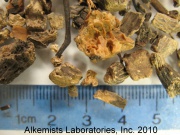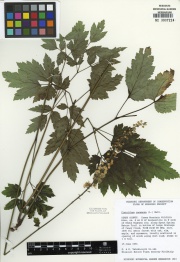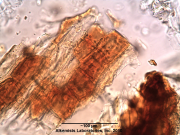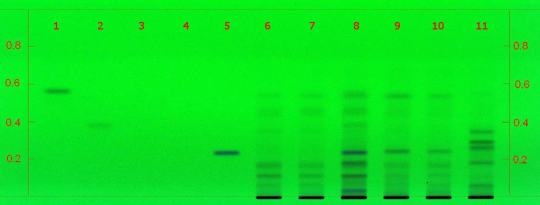Actaea racemosa (root and rhizome)
Contents |
Introduction
Introduction from Wikipedia, the free encyclopedia (http://en.wikipedia.org/wiki/Actaea_racemosa, retrieved 02/20/2012).
Actaea racemosa (black cohosh, black bugbane, black snakeroot, fairy candle; syn. Cimicifuga racemosa) is a plant of the buttercup family (Ranunculaceae). It is native to eastern North America from the extreme south of Ontario to central Georgia, and west to Missouri and Arkansas. Black cohosh grows in a variety of woodland habitats, and is often found in small woodland openings. The roots and rhizomes of black cohosh have long been used medicinally by Native Americans. Extracts from these plant materials are thought to possess analgesic, sedative, and anti-inflammatory properties. Today, black cohosh preparations (tinctures or tablets of dried materials) are used mainly to treat symptoms associated with menopause.
The quoted text in this section was licensed for use under the Creative Commons ShareAlike License, version 3.0: http://creativecommons.org/licenses/by-sa/3.0/
Macroscopic Entries
|
|
Microscopic Entries
|
HPTLC Entries
|
Black Cohosh (root) (Actaea racemosa) Lane Assignments Lanes, from left to right (Track, Volume, Sample):
Reference Sample(s) Reference: Dissolve 1mg of actein, 23-epi-26-deoxyactein, isoferulic acid, cimifugin and/or norcimifugin individually in 10 mL of methanol. Stationary Phase Stationary phase, i.e. Silica gel 60, F254 Mobile Phase Toluene, ethyl formate, formic acid 50:30:20 (v/v/v) Sample Preparation Method Sample: Mix 0.5 g of powdered sample with 10 mL of an ethanolwater mixture (1:1) and sonicate for 10 minutes, then centrifuge or filter the solutions and use the supernatants/filtrates as test solutions. Sulfuric Acid Reagent: Preparation: 20 mL of sulfuric acid are mixed with 180 mL of ice-cooled methanol Detection Method UV/Vis, Sulfuric Acid Reagent Use: Dip (time 0, speed 5), heat at 100°C for 5 min Other Notes Compare result under UV 254 nm and white RT with reference images in Image Comparison Viewer. The fingerprint of the test solution is similar to that of the corresponding botanical reference sample. Additional weak zones may be present. C. racemosa Identification: Under UV 254 nm the chromatogram obtained with the test solution does not show a dark zone at the position of Cimifugin in the reference solution or just above it. Under white RT a characteristic fingerprint is detected. Below Cimifugin there are two violet zones. Just above the application position two brown zones are detected (blue arrow). There is no brown zone at the position of cimifugin, but there might be a faint violet zone. There is a brown zone at the position of actein as well as two brown zone just below. Just above the actein zone is a very thin brown zone (green arrow). Further methodology available here, in Identification of black cohosh by HPTLC. Source: AHPA Practical, CAMAG HPTLC [4] |
Other Points of Interest
Black Cohosh (root) (Actaea racemosa, syn Cimicifuga racemosa)
General Characteristics AHPA recommends in its Known Adulterants list that appropriate steps be taken to assure that this raw material is free of the noted adulterant. Contact AHPA for additional information regarding relevant analytical methods or follow this link for more information.
Reported Adulterants Chinese cimicifuga (root) (Actaea spp.). Also known as sheng ma or Rhizoma Cimicifugae; consists of Actaea cimicifuga, syn. Cimicifuga foetida; Actaea dahurica, syn. C. dahurica; A. heracleifolia, syn. C. heracleifolia; and possibly other Asian species of Actaea.
Source: AHPA Known Adulterants [5]
AHPA Practical: Detecting Adulteration of Black Cohosh (Actaea racemosa syn. Cimicifuga racemosa) root/rhizome
Reproduced from [1].
Introduction
The American Herbal Products Association is providing here analytical tools and methods to identify adulteration of raw materials and dietary ingredients labeled as black cohosh (Actaea racemosa syn. Cimicifuga racemosa) root/rhizome, or extracts thereof. This information is provided for industry in order to deal appropriately with reports of adulteration of this ingredient and make wise purchasing decisions.
Background
The economic adulteration of black cohosh root and rhizome with other species is well established. AHPA’s guidance policy on Known Adulterants identifies Chinese cimicifuga root/rhizome, also known as sheng ma or Rhizoma Cimicifugae as known black cohosh adulterants. This material commonly consists of Actaea cimicifuga, syn. Cimicifuga foetida; Actaea dahurica, syn. C. dahurica; A. heracleifolia, syn. C. heracleifolia; and possibly other Asian species of Actaea. The citation below provides a review of Rhizoma Cimicifugae for those wanting additional information.
Li JX, Yu ZY. Cimicifugae rhizoma: from origins, bioactive constituents to clinical outcomes. Curr Med Chem. 2006;13(24):2927-51.
The black cohosh monograph in the Natural Health Ingredients Database of the Canadian Natural Health Products Directorate at Health Canada, available online here or as a pdf file here, references instances where adverse events associated with ingestion of products labeled as containing black cohosh (Actaea racemosa syn. Cimicifuga racemosa) were found to contain plant species that were not black cohosh upon laboratory analysis. The Canadian Adverse Reaction Newsletter (2010 Jan;20(1):1-2) provided specifics on this situation as covered in a January 14, 2010 AHPA Update.
Analytical tools
There are several analytical tools available for the authentication of genuine black cohosh and its differentiation from other species. Two papers detailing the use of high performance thin-layer chromatography (HPTLC) are cited below. The first focuses on detection of black cohosh adulteration by other North American Actaea species while the second deals more specifically with differentiation of black cohosh from Chinese cimicifuga. The full methodology for the HPTLC analysis of the second citation can be accessed via this: Identification of black cohosh by HPTLC.
The third citation below employed phytochemical “fingerprinting” using high-performance liquid chromatography with a photo-diode array detector (HPLC-PDA) and liquid chromatography with mass spectrometry detection (LC-MS) to authenticate black cohosh and differentiate it from 14 other Actaea species.
Verbitski SM, Gourdin GT, Ikenouye LM, McChesney JD, Hildreth J. Detection of Actaea racemosa adulteration by thin-layer chromatography and combined thin-layer chromatography-bioluminescence. J AOAC Int. 2008 Mar-Apr;91(2):268-75.
Ankli A, Reich E, Steiner M. Rapid high-performance thin-layer chromatographic method for detection of 5% adulteration of black cohosh with Cimicifuga foetida, C. heracleifolia, C. dahurica, or C. americana. J AOAC Int. 2008 Nov-Dec;91(6):1257-64.
Jiang B, Ma C, Motley T, Kronenberg F, Kennelly EJ. Phytochemical fingerprinting to thwart black cohosh adulteration: a 15 Actaea species analysis. Phytochem Anal. 2011 Feb 19. doi: 10.1002/pca.1285. [Epub ahead of print] Supporting information is available here.
The black cohosh monograph in the Natural Health Ingredients Database of the Canadian Natural Health Products Directorate at Health Canada, available online here or as a pdf file here, references instances where adverse events associated with ingestion of products labeled as containing black cohosh (Actaea racemosa syn. Cimicifuga racemosa) were found to contain plant species that were not black cohosh upon laboratory analysis. The Canadian Adverse Reaction Newsletter (2010 Jan;20(1):1-2) provided specifics on this situation as covered in a January 14, 2010 AHPA Update.
The American Herbal Pharmacopoeia and the USP Dietary Supplements Compendium also contain useful information for the differentiation of black cohosh and other species representing common black cohosh adulterants. Authenticated black cohosh reference materials are available from both organizations as well as AHPA member companies Alkemists Laboratories, Botanical Liaisons, and Chromadex. DNA testing can be used to verify authentic species, and rule out the presence of common or other unexpected DNA-containing adulterants or contaminants. Work in this area is currently being conducted by AHPA member AuthenTechnologies.
Cite error: <ref> tags exist, but no <references/> tag was found





